Comprehensive Report: Organizational Behaviour at ASDA Stores Ltd
VerifiedAdded on 2021/02/20
|15
|4723
|63
Report
AI Summary
This report provides a comprehensive analysis of organizational behaviour within ASDA Stores Ltd. It begins by examining the influence of culture, politics, and power on individual and team performance, exploring different organizational cultures such as power, role, task, and personal cultures. The report then delves into motivational theories, differentiating between intrinsic and extrinsic motivation, and evaluating content theories like Maslow's Hierarchy of Needs, and process theories such as Vroom's Expectancy Theory. It further explores effective team building and cooperation, analyzing relevant team and group management theories. Finally, the report discusses concepts and philosophies of organizational behaviour, including the Path-goals Theory of Leadership, Contingency Theory, and Social Capital Theory, assessing their positive and negative impacts on organizational behaviour. The report concludes with a critical analysis of team development theories and concepts' relevancy within ASDA, providing insights into the retailer's organizational dynamics.
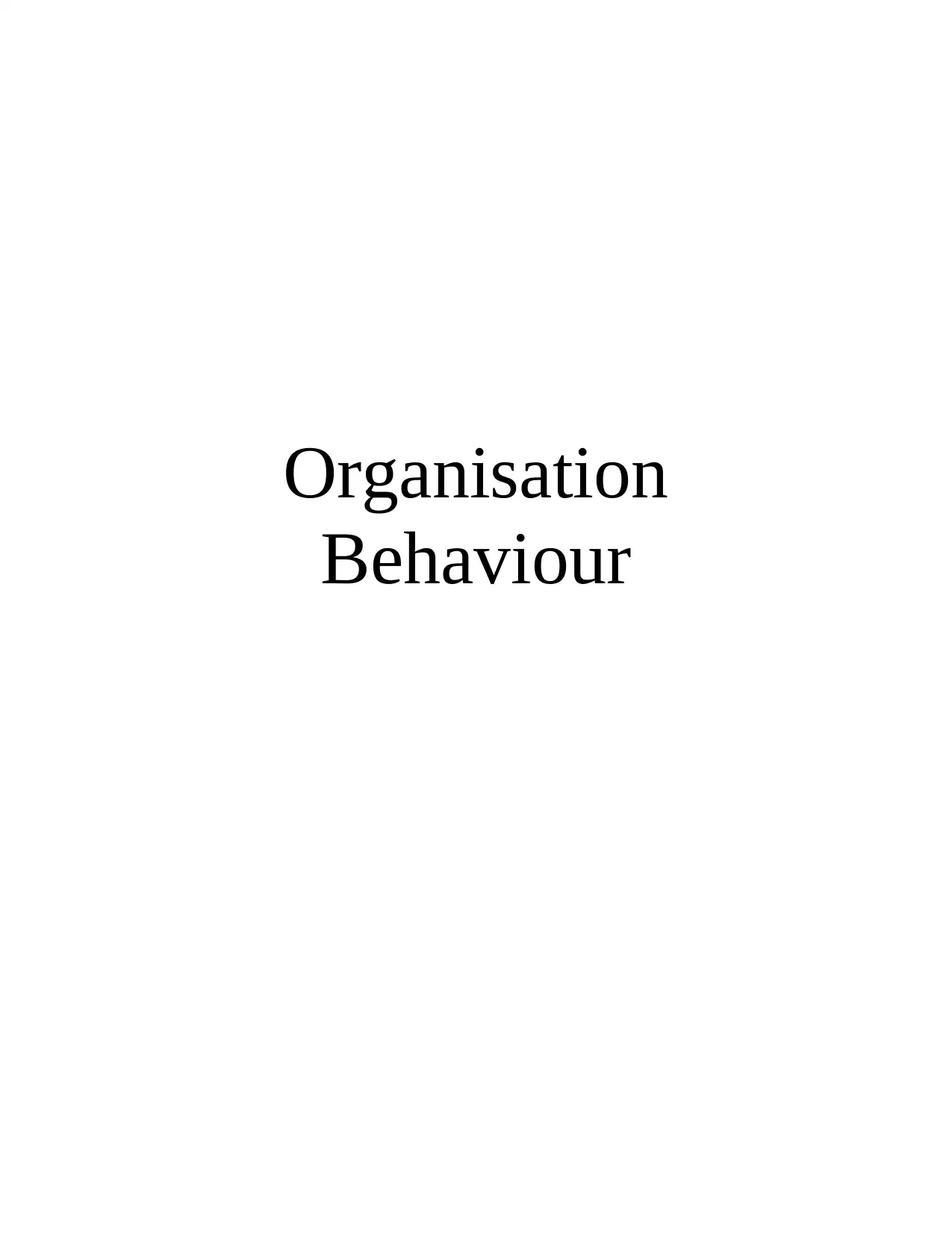
Organisation
Behaviour
Behaviour
Paraphrase This Document
Need a fresh take? Get an instant paraphrase of this document with our AI Paraphraser
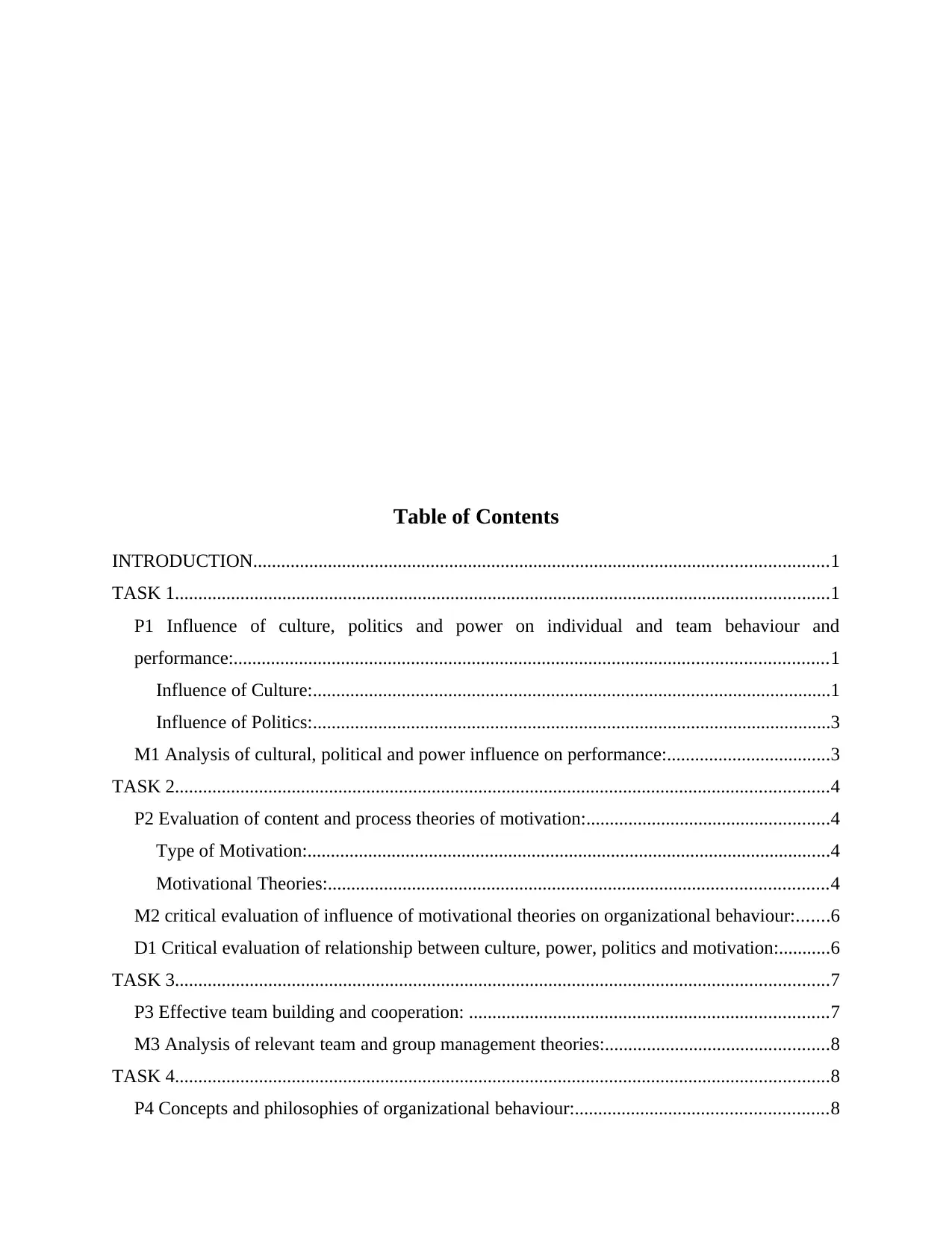
Table of Contents
INTRODUCTION...........................................................................................................................1
TASK 1............................................................................................................................................1
P1 Influence of culture, politics and power on individual and team behaviour and
performance:...............................................................................................................................1
Influence of Culture:...............................................................................................................1
Influence of Politics:...............................................................................................................3
M1 Analysis of cultural, political and power influence on performance:...................................3
TASK 2............................................................................................................................................4
P2 Evaluation of content and process theories of motivation:....................................................4
Type of Motivation:................................................................................................................4
Motivational Theories:...........................................................................................................4
M2 critical evaluation of influence of motivational theories on organizational behaviour:.......6
D1 Critical evaluation of relationship between culture, power, politics and motivation:...........6
TASK 3............................................................................................................................................7
P3 Effective team building and cooperation: .............................................................................7
M3 Analysis of relevant team and group management theories:................................................8
TASK 4............................................................................................................................................8
P4 Concepts and philosophies of organizational behaviour:......................................................8
INTRODUCTION...........................................................................................................................1
TASK 1............................................................................................................................................1
P1 Influence of culture, politics and power on individual and team behaviour and
performance:...............................................................................................................................1
Influence of Culture:...............................................................................................................1
Influence of Politics:...............................................................................................................3
M1 Analysis of cultural, political and power influence on performance:...................................3
TASK 2............................................................................................................................................4
P2 Evaluation of content and process theories of motivation:....................................................4
Type of Motivation:................................................................................................................4
Motivational Theories:...........................................................................................................4
M2 critical evaluation of influence of motivational theories on organizational behaviour:.......6
D1 Critical evaluation of relationship between culture, power, politics and motivation:...........6
TASK 3............................................................................................................................................7
P3 Effective team building and cooperation: .............................................................................7
M3 Analysis of relevant team and group management theories:................................................8
TASK 4............................................................................................................................................8
P4 Concepts and philosophies of organizational behaviour:......................................................8
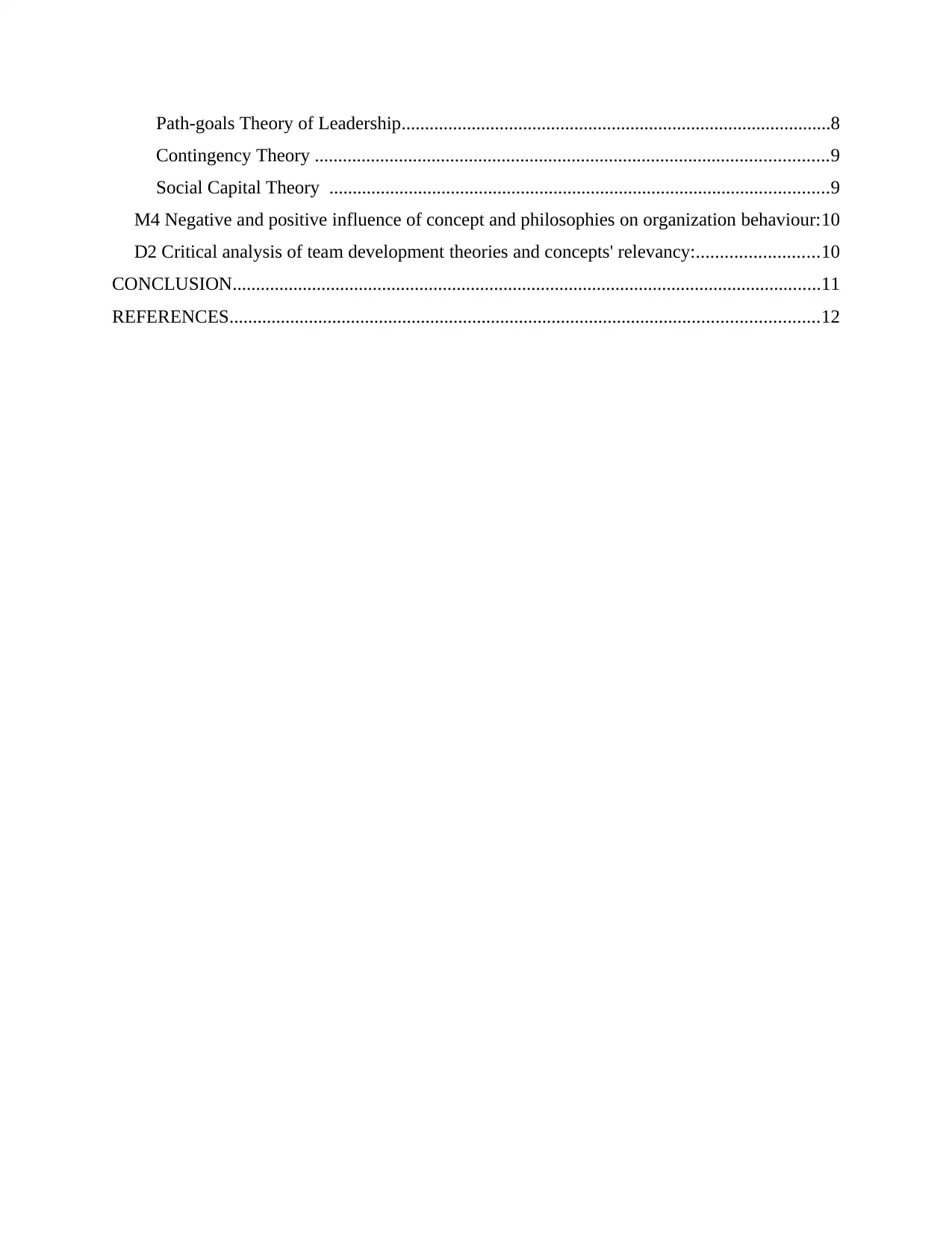
Path-goals Theory of Leadership............................................................................................8
Contingency Theory ..............................................................................................................9
Social Capital Theory ...........................................................................................................9
M4 Negative and positive influence of concept and philosophies on organization behaviour:10
D2 Critical analysis of team development theories and concepts' relevancy:..........................10
CONCLUSION..............................................................................................................................11
REFERENCES..............................................................................................................................12
Contingency Theory ..............................................................................................................9
Social Capital Theory ...........................................................................................................9
M4 Negative and positive influence of concept and philosophies on organization behaviour:10
D2 Critical analysis of team development theories and concepts' relevancy:..........................10
CONCLUSION..............................................................................................................................11
REFERENCES..............................................................................................................................12
⊘ This is a preview!⊘
Do you want full access?
Subscribe today to unlock all pages.

Trusted by 1+ million students worldwide
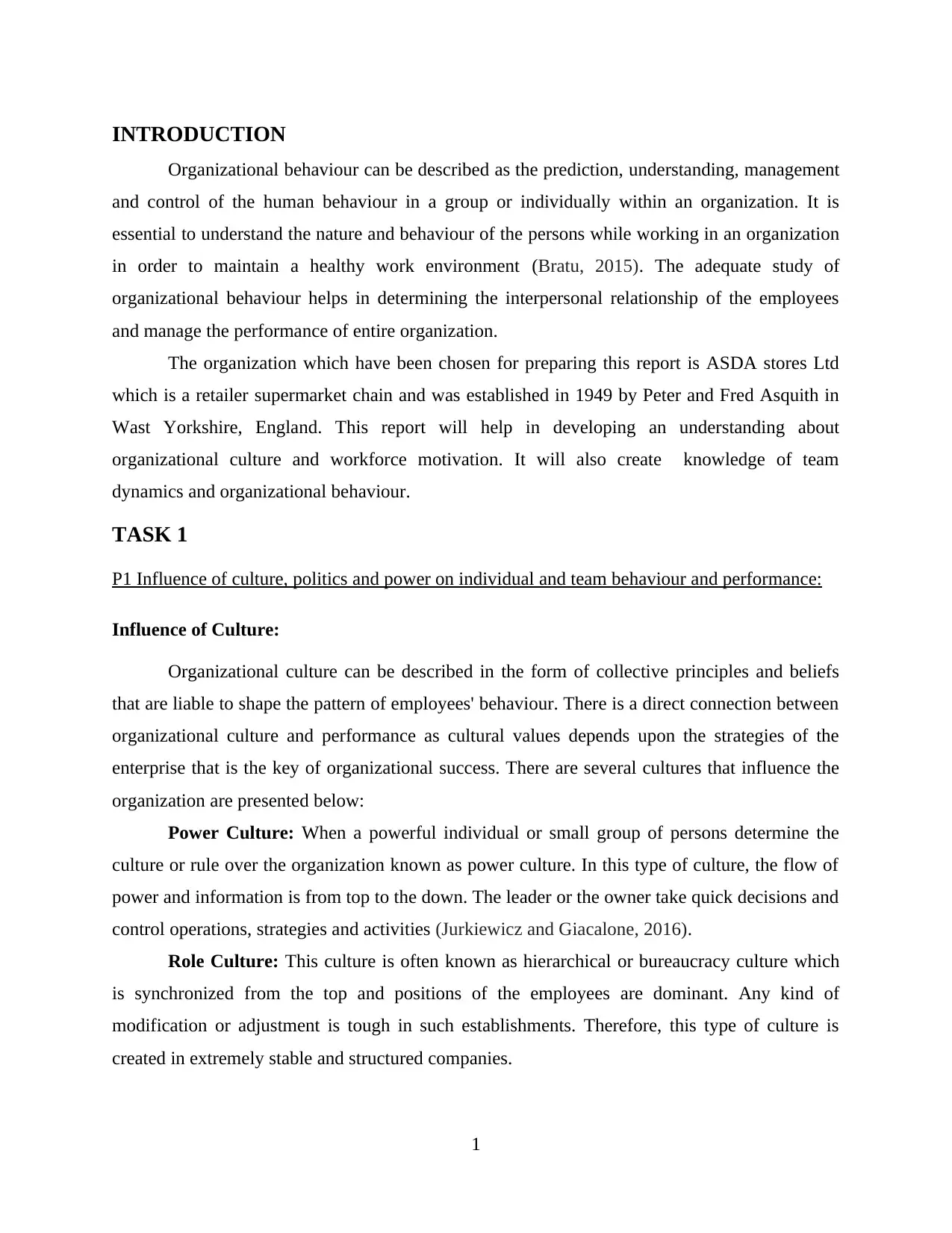
INTRODUCTION
Organizational behaviour can be described as the prediction, understanding, management
and control of the human behaviour in a group or individually within an organization. It is
essential to understand the nature and behaviour of the persons while working in an organization
in order to maintain a healthy work environment (Bratu, 2015). The adequate study of
organizational behaviour helps in determining the interpersonal relationship of the employees
and manage the performance of entire organization.
The organization which have been chosen for preparing this report is ASDA stores Ltd
which is a retailer supermarket chain and was established in 1949 by Peter and Fred Asquith in
Wast Yorkshire, England. This report will help in developing an understanding about
organizational culture and workforce motivation. It will also create knowledge of team
dynamics and organizational behaviour.
TASK 1
P1 Influence of culture, politics and power on individual and team behaviour and performance:
Influence of Culture:
Organizational culture can be described in the form of collective principles and beliefs
that are liable to shape the pattern of employees' behaviour. There is a direct connection between
organizational culture and performance as cultural values depends upon the strategies of the
enterprise that is the key of organizational success. There are several cultures that influence the
organization are presented below:
Power Culture: When a powerful individual or small group of persons determine the
culture or rule over the organization known as power culture. In this type of culture, the flow of
power and information is from top to the down. The leader or the owner take quick decisions and
control operations, strategies and activities (Jurkiewicz and Giacalone, 2016).
Role Culture: This culture is often known as hierarchical or bureaucracy culture which
is synchronized from the top and positions of the employees are dominant. Any kind of
modification or adjustment is tough in such establishments. Therefore, this type of culture is
created in extremely stable and structured companies.
1
Organizational behaviour can be described as the prediction, understanding, management
and control of the human behaviour in a group or individually within an organization. It is
essential to understand the nature and behaviour of the persons while working in an organization
in order to maintain a healthy work environment (Bratu, 2015). The adequate study of
organizational behaviour helps in determining the interpersonal relationship of the employees
and manage the performance of entire organization.
The organization which have been chosen for preparing this report is ASDA stores Ltd
which is a retailer supermarket chain and was established in 1949 by Peter and Fred Asquith in
Wast Yorkshire, England. This report will help in developing an understanding about
organizational culture and workforce motivation. It will also create knowledge of team
dynamics and organizational behaviour.
TASK 1
P1 Influence of culture, politics and power on individual and team behaviour and performance:
Influence of Culture:
Organizational culture can be described in the form of collective principles and beliefs
that are liable to shape the pattern of employees' behaviour. There is a direct connection between
organizational culture and performance as cultural values depends upon the strategies of the
enterprise that is the key of organizational success. There are several cultures that influence the
organization are presented below:
Power Culture: When a powerful individual or small group of persons determine the
culture or rule over the organization known as power culture. In this type of culture, the flow of
power and information is from top to the down. The leader or the owner take quick decisions and
control operations, strategies and activities (Jurkiewicz and Giacalone, 2016).
Role Culture: This culture is often known as hierarchical or bureaucracy culture which
is synchronized from the top and positions of the employees are dominant. Any kind of
modification or adjustment is tough in such establishments. Therefore, this type of culture is
created in extremely stable and structured companies.
1
Paraphrase This Document
Need a fresh take? Get an instant paraphrase of this document with our AI Paraphraser
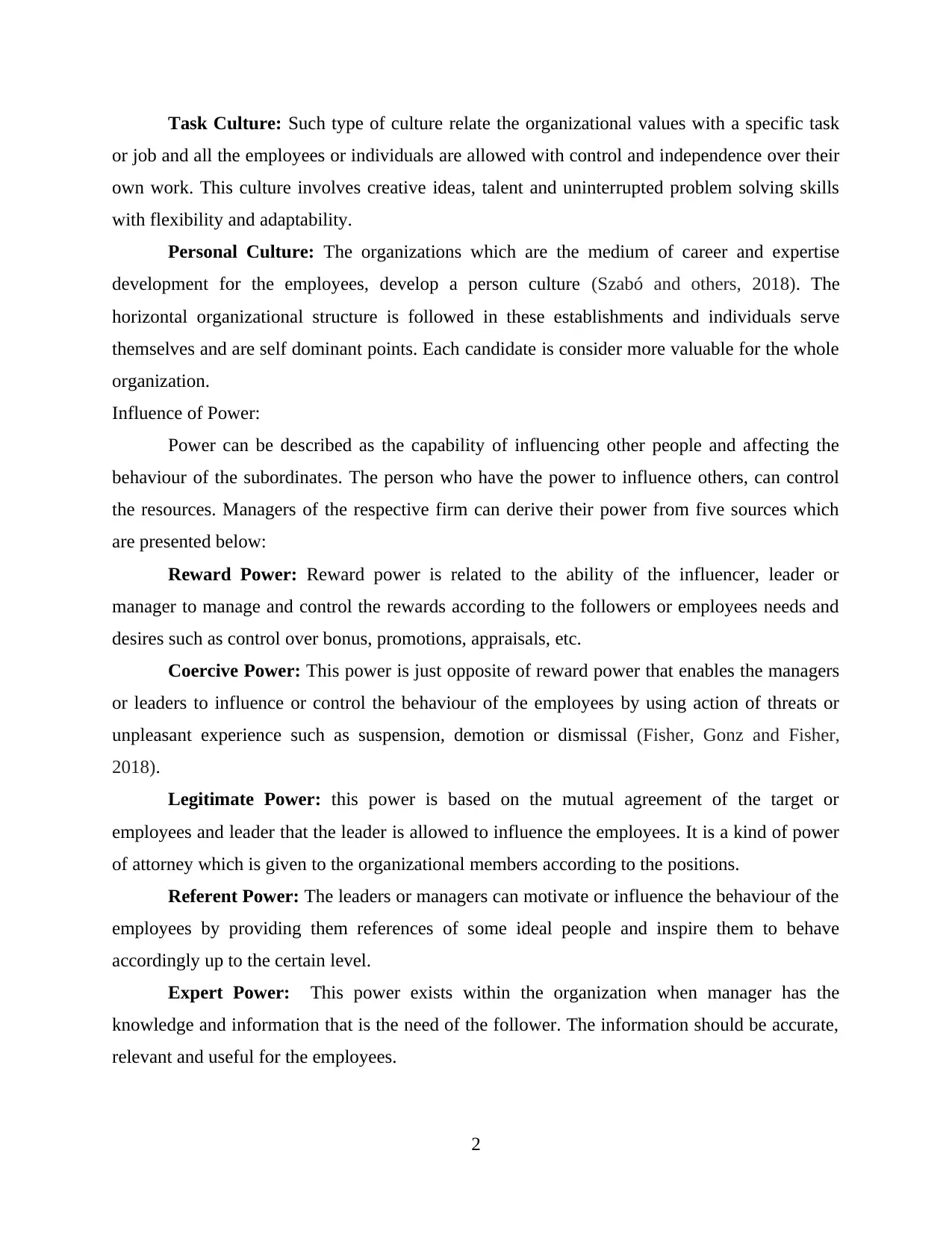
Task Culture: Such type of culture relate the organizational values with a specific task
or job and all the employees or individuals are allowed with control and independence over their
own work. This culture involves creative ideas, talent and uninterrupted problem solving skills
with flexibility and adaptability.
Personal Culture: The organizations which are the medium of career and expertise
development for the employees, develop a person culture (Szabó and others, 2018). The
horizontal organizational structure is followed in these establishments and individuals serve
themselves and are self dominant points. Each candidate is consider more valuable for the whole
organization.
Influence of Power:
Power can be described as the capability of influencing other people and affecting the
behaviour of the subordinates. The person who have the power to influence others, can control
the resources. Managers of the respective firm can derive their power from five sources which
are presented below:
Reward Power: Reward power is related to the ability of the influencer, leader or
manager to manage and control the rewards according to the followers or employees needs and
desires such as control over bonus, promotions, appraisals, etc.
Coercive Power: This power is just opposite of reward power that enables the managers
or leaders to influence or control the behaviour of the employees by using action of threats or
unpleasant experience such as suspension, demotion or dismissal (Fisher, Gonz and Fisher,
2018).
Legitimate Power: this power is based on the mutual agreement of the target or
employees and leader that the leader is allowed to influence the employees. It is a kind of power
of attorney which is given to the organizational members according to the positions.
Referent Power: The leaders or managers can motivate or influence the behaviour of the
employees by providing them references of some ideal people and inspire them to behave
accordingly up to the certain level.
Expert Power: This power exists within the organization when manager has the
knowledge and information that is the need of the follower. The information should be accurate,
relevant and useful for the employees.
2
or job and all the employees or individuals are allowed with control and independence over their
own work. This culture involves creative ideas, talent and uninterrupted problem solving skills
with flexibility and adaptability.
Personal Culture: The organizations which are the medium of career and expertise
development for the employees, develop a person culture (Szabó and others, 2018). The
horizontal organizational structure is followed in these establishments and individuals serve
themselves and are self dominant points. Each candidate is consider more valuable for the whole
organization.
Influence of Power:
Power can be described as the capability of influencing other people and affecting the
behaviour of the subordinates. The person who have the power to influence others, can control
the resources. Managers of the respective firm can derive their power from five sources which
are presented below:
Reward Power: Reward power is related to the ability of the influencer, leader or
manager to manage and control the rewards according to the followers or employees needs and
desires such as control over bonus, promotions, appraisals, etc.
Coercive Power: This power is just opposite of reward power that enables the managers
or leaders to influence or control the behaviour of the employees by using action of threats or
unpleasant experience such as suspension, demotion or dismissal (Fisher, Gonz and Fisher,
2018).
Legitimate Power: this power is based on the mutual agreement of the target or
employees and leader that the leader is allowed to influence the employees. It is a kind of power
of attorney which is given to the organizational members according to the positions.
Referent Power: The leaders or managers can motivate or influence the behaviour of the
employees by providing them references of some ideal people and inspire them to behave
accordingly up to the certain level.
Expert Power: This power exists within the organization when manager has the
knowledge and information that is the need of the follower. The information should be accurate,
relevant and useful for the employees.
2
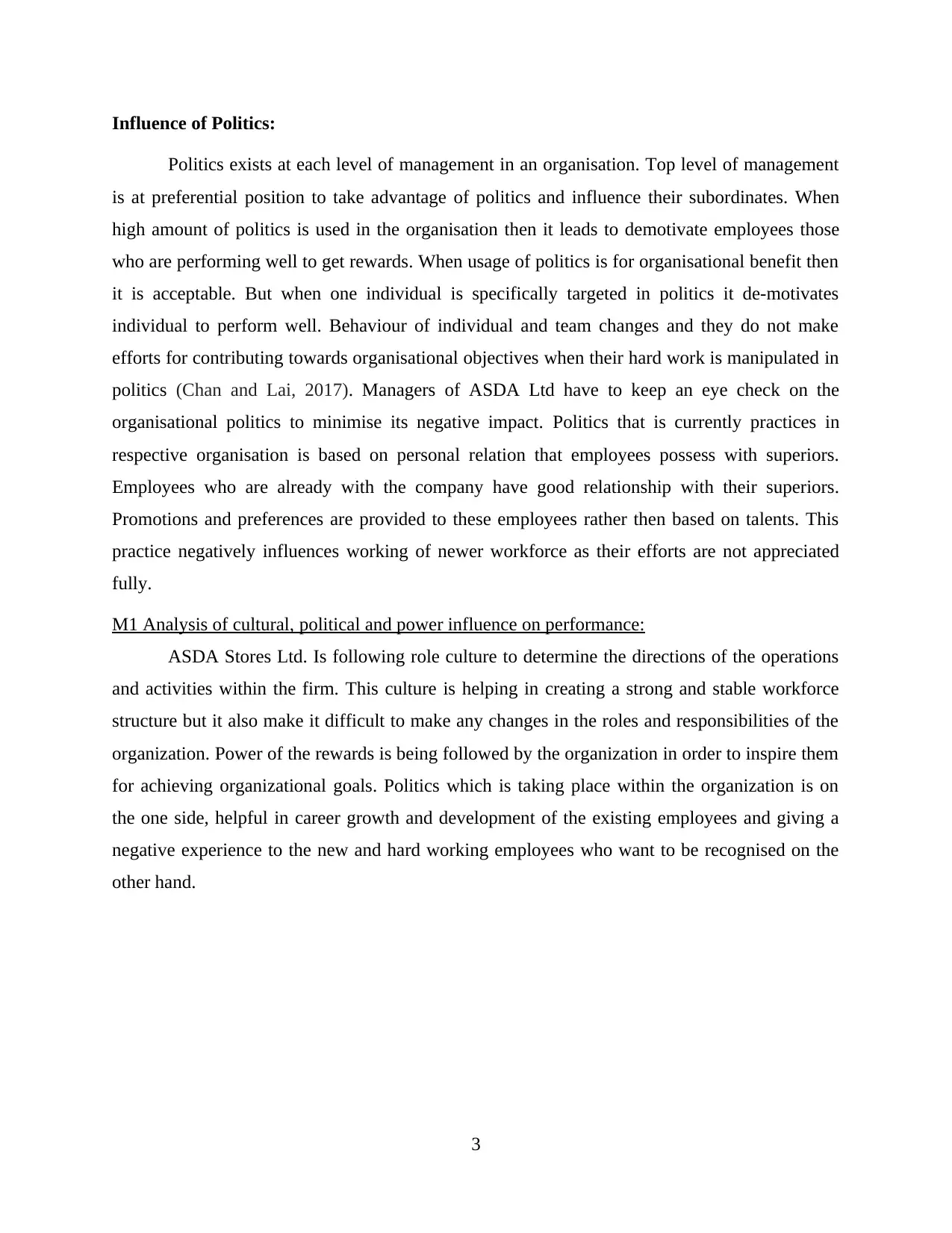
Influence of Politics:
Politics exists at each level of management in an organisation. Top level of management
is at preferential position to take advantage of politics and influence their subordinates. When
high amount of politics is used in the organisation then it leads to demotivate employees those
who are performing well to get rewards. When usage of politics is for organisational benefit then
it is acceptable. But when one individual is specifically targeted in politics it de-motivates
individual to perform well. Behaviour of individual and team changes and they do not make
efforts for contributing towards organisational objectives when their hard work is manipulated in
politics (Chan and Lai, 2017). Managers of ASDA Ltd have to keep an eye check on the
organisational politics to minimise its negative impact. Politics that is currently practices in
respective organisation is based on personal relation that employees possess with superiors.
Employees who are already with the company have good relationship with their superiors.
Promotions and preferences are provided to these employees rather then based on talents. This
practice negatively influences working of newer workforce as their efforts are not appreciated
fully.
M1 Analysis of cultural, political and power influence on performance:
ASDA Stores Ltd. Is following role culture to determine the directions of the operations
and activities within the firm. This culture is helping in creating a strong and stable workforce
structure but it also make it difficult to make any changes in the roles and responsibilities of the
organization. Power of the rewards is being followed by the organization in order to inspire them
for achieving organizational goals. Politics which is taking place within the organization is on
the one side, helpful in career growth and development of the existing employees and giving a
negative experience to the new and hard working employees who want to be recognised on the
other hand.
3
Politics exists at each level of management in an organisation. Top level of management
is at preferential position to take advantage of politics and influence their subordinates. When
high amount of politics is used in the organisation then it leads to demotivate employees those
who are performing well to get rewards. When usage of politics is for organisational benefit then
it is acceptable. But when one individual is specifically targeted in politics it de-motivates
individual to perform well. Behaviour of individual and team changes and they do not make
efforts for contributing towards organisational objectives when their hard work is manipulated in
politics (Chan and Lai, 2017). Managers of ASDA Ltd have to keep an eye check on the
organisational politics to minimise its negative impact. Politics that is currently practices in
respective organisation is based on personal relation that employees possess with superiors.
Employees who are already with the company have good relationship with their superiors.
Promotions and preferences are provided to these employees rather then based on talents. This
practice negatively influences working of newer workforce as their efforts are not appreciated
fully.
M1 Analysis of cultural, political and power influence on performance:
ASDA Stores Ltd. Is following role culture to determine the directions of the operations
and activities within the firm. This culture is helping in creating a strong and stable workforce
structure but it also make it difficult to make any changes in the roles and responsibilities of the
organization. Power of the rewards is being followed by the organization in order to inspire them
for achieving organizational goals. Politics which is taking place within the organization is on
the one side, helpful in career growth and development of the existing employees and giving a
negative experience to the new and hard working employees who want to be recognised on the
other hand.
3
⊘ This is a preview!⊘
Do you want full access?
Subscribe today to unlock all pages.

Trusted by 1+ million students worldwide
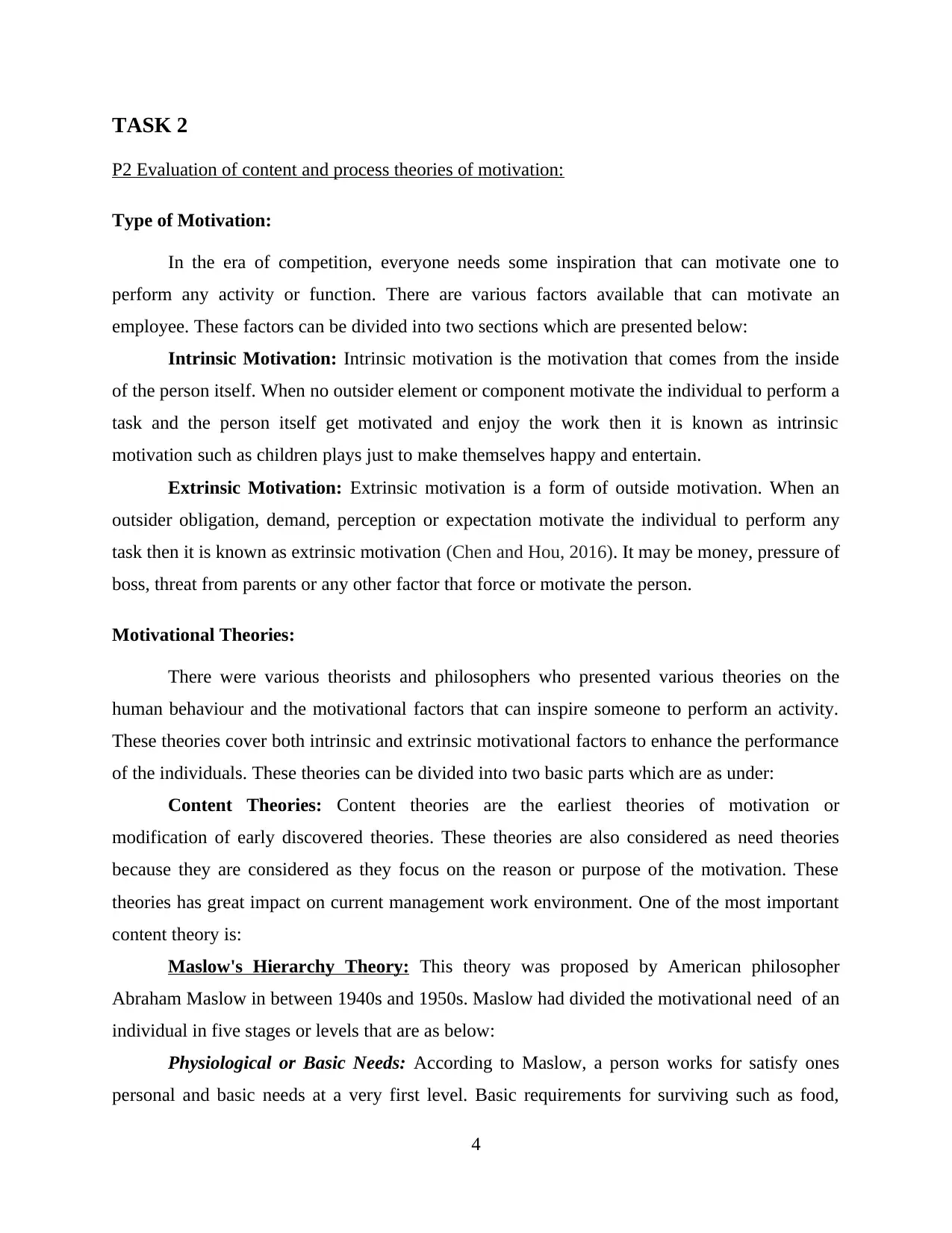
TASK 2
P2 Evaluation of content and process theories of motivation:
Type of Motivation:
In the era of competition, everyone needs some inspiration that can motivate one to
perform any activity or function. There are various factors available that can motivate an
employee. These factors can be divided into two sections which are presented below:
Intrinsic Motivation: Intrinsic motivation is the motivation that comes from the inside
of the person itself. When no outsider element or component motivate the individual to perform a
task and the person itself get motivated and enjoy the work then it is known as intrinsic
motivation such as children plays just to make themselves happy and entertain.
Extrinsic Motivation: Extrinsic motivation is a form of outside motivation. When an
outsider obligation, demand, perception or expectation motivate the individual to perform any
task then it is known as extrinsic motivation (Chen and Hou, 2016). It may be money, pressure of
boss, threat from parents or any other factor that force or motivate the person.
Motivational Theories:
There were various theorists and philosophers who presented various theories on the
human behaviour and the motivational factors that can inspire someone to perform an activity.
These theories cover both intrinsic and extrinsic motivational factors to enhance the performance
of the individuals. These theories can be divided into two basic parts which are as under:
Content Theories: Content theories are the earliest theories of motivation or
modification of early discovered theories. These theories are also considered as need theories
because they are considered as they focus on the reason or purpose of the motivation. These
theories has great impact on current management work environment. One of the most important
content theory is:
Maslow's Hierarchy Theory: This theory was proposed by American philosopher
Abraham Maslow in between 1940s and 1950s. Maslow had divided the motivational need of an
individual in five stages or levels that are as below:
Physiological or Basic Needs: According to Maslow, a person works for satisfy ones
personal and basic needs at a very first level. Basic requirements for surviving such as food,
4
P2 Evaluation of content and process theories of motivation:
Type of Motivation:
In the era of competition, everyone needs some inspiration that can motivate one to
perform any activity or function. There are various factors available that can motivate an
employee. These factors can be divided into two sections which are presented below:
Intrinsic Motivation: Intrinsic motivation is the motivation that comes from the inside
of the person itself. When no outsider element or component motivate the individual to perform a
task and the person itself get motivated and enjoy the work then it is known as intrinsic
motivation such as children plays just to make themselves happy and entertain.
Extrinsic Motivation: Extrinsic motivation is a form of outside motivation. When an
outsider obligation, demand, perception or expectation motivate the individual to perform any
task then it is known as extrinsic motivation (Chen and Hou, 2016). It may be money, pressure of
boss, threat from parents or any other factor that force or motivate the person.
Motivational Theories:
There were various theorists and philosophers who presented various theories on the
human behaviour and the motivational factors that can inspire someone to perform an activity.
These theories cover both intrinsic and extrinsic motivational factors to enhance the performance
of the individuals. These theories can be divided into two basic parts which are as under:
Content Theories: Content theories are the earliest theories of motivation or
modification of early discovered theories. These theories are also considered as need theories
because they are considered as they focus on the reason or purpose of the motivation. These
theories has great impact on current management work environment. One of the most important
content theory is:
Maslow's Hierarchy Theory: This theory was proposed by American philosopher
Abraham Maslow in between 1940s and 1950s. Maslow had divided the motivational need of an
individual in five stages or levels that are as below:
Physiological or Basic Needs: According to Maslow, a person works for satisfy ones
personal and basic needs at a very first level. Basic requirements for surviving such as food,
4
Paraphrase This Document
Need a fresh take? Get an instant paraphrase of this document with our AI Paraphraser
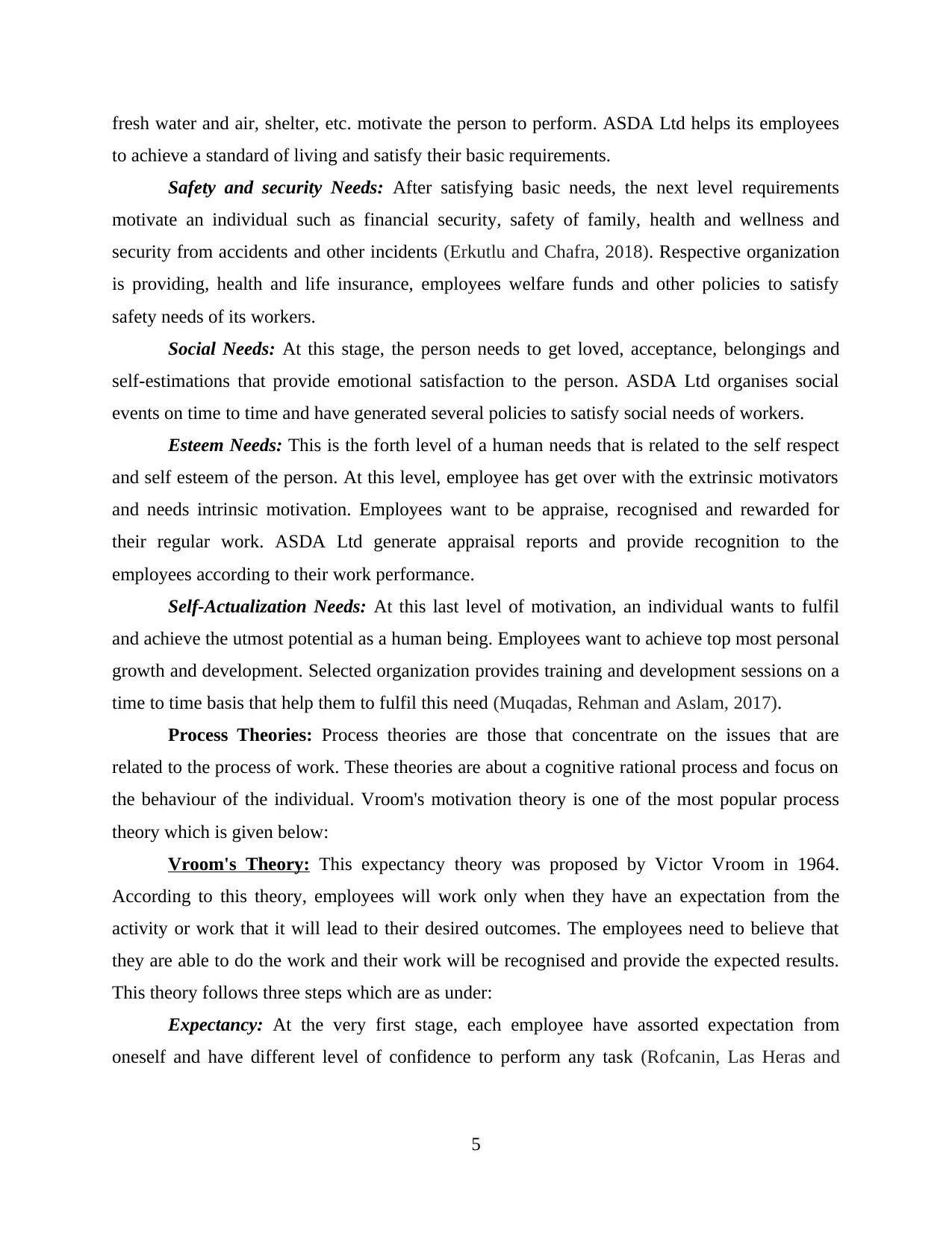
fresh water and air, shelter, etc. motivate the person to perform. ASDA Ltd helps its employees
to achieve a standard of living and satisfy their basic requirements.
Safety and security Needs: After satisfying basic needs, the next level requirements
motivate an individual such as financial security, safety of family, health and wellness and
security from accidents and other incidents (Erkutlu and Chafra, 2018). Respective organization
is providing, health and life insurance, employees welfare funds and other policies to satisfy
safety needs of its workers.
Social Needs: At this stage, the person needs to get loved, acceptance, belongings and
self-estimations that provide emotional satisfaction to the person. ASDA Ltd organises social
events on time to time and have generated several policies to satisfy social needs of workers.
Esteem Needs: This is the forth level of a human needs that is related to the self respect
and self esteem of the person. At this level, employee has get over with the extrinsic motivators
and needs intrinsic motivation. Employees want to be appraise, recognised and rewarded for
their regular work. ASDA Ltd generate appraisal reports and provide recognition to the
employees according to their work performance.
Self-Actualization Needs: At this last level of motivation, an individual wants to fulfil
and achieve the utmost potential as a human being. Employees want to achieve top most personal
growth and development. Selected organization provides training and development sessions on a
time to time basis that help them to fulfil this need (Muqadas, Rehman and Aslam, 2017).
Process Theories: Process theories are those that concentrate on the issues that are
related to the process of work. These theories are about a cognitive rational process and focus on
the behaviour of the individual. Vroom's motivation theory is one of the most popular process
theory which is given below:
Vroom's Theory: This expectancy theory was proposed by Victor Vroom in 1964.
According to this theory, employees will work only when they have an expectation from the
activity or work that it will lead to their desired outcomes. The employees need to believe that
they are able to do the work and their work will be recognised and provide the expected results.
This theory follows three steps which are as under:
Expectancy: At the very first stage, each employee have assorted expectation from
oneself and have different level of confidence to perform any task (Rofcanin, Las Heras and
5
to achieve a standard of living and satisfy their basic requirements.
Safety and security Needs: After satisfying basic needs, the next level requirements
motivate an individual such as financial security, safety of family, health and wellness and
security from accidents and other incidents (Erkutlu and Chafra, 2018). Respective organization
is providing, health and life insurance, employees welfare funds and other policies to satisfy
safety needs of its workers.
Social Needs: At this stage, the person needs to get loved, acceptance, belongings and
self-estimations that provide emotional satisfaction to the person. ASDA Ltd organises social
events on time to time and have generated several policies to satisfy social needs of workers.
Esteem Needs: This is the forth level of a human needs that is related to the self respect
and self esteem of the person. At this level, employee has get over with the extrinsic motivators
and needs intrinsic motivation. Employees want to be appraise, recognised and rewarded for
their regular work. ASDA Ltd generate appraisal reports and provide recognition to the
employees according to their work performance.
Self-Actualization Needs: At this last level of motivation, an individual wants to fulfil
and achieve the utmost potential as a human being. Employees want to achieve top most personal
growth and development. Selected organization provides training and development sessions on a
time to time basis that help them to fulfil this need (Muqadas, Rehman and Aslam, 2017).
Process Theories: Process theories are those that concentrate on the issues that are
related to the process of work. These theories are about a cognitive rational process and focus on
the behaviour of the individual. Vroom's motivation theory is one of the most popular process
theory which is given below:
Vroom's Theory: This expectancy theory was proposed by Victor Vroom in 1964.
According to this theory, employees will work only when they have an expectation from the
activity or work that it will lead to their desired outcomes. The employees need to believe that
they are able to do the work and their work will be recognised and provide the expected results.
This theory follows three steps which are as under:
Expectancy: At the very first stage, each employee have assorted expectation from
oneself and have different level of confidence to perform any task (Rofcanin, Las Heras and
5
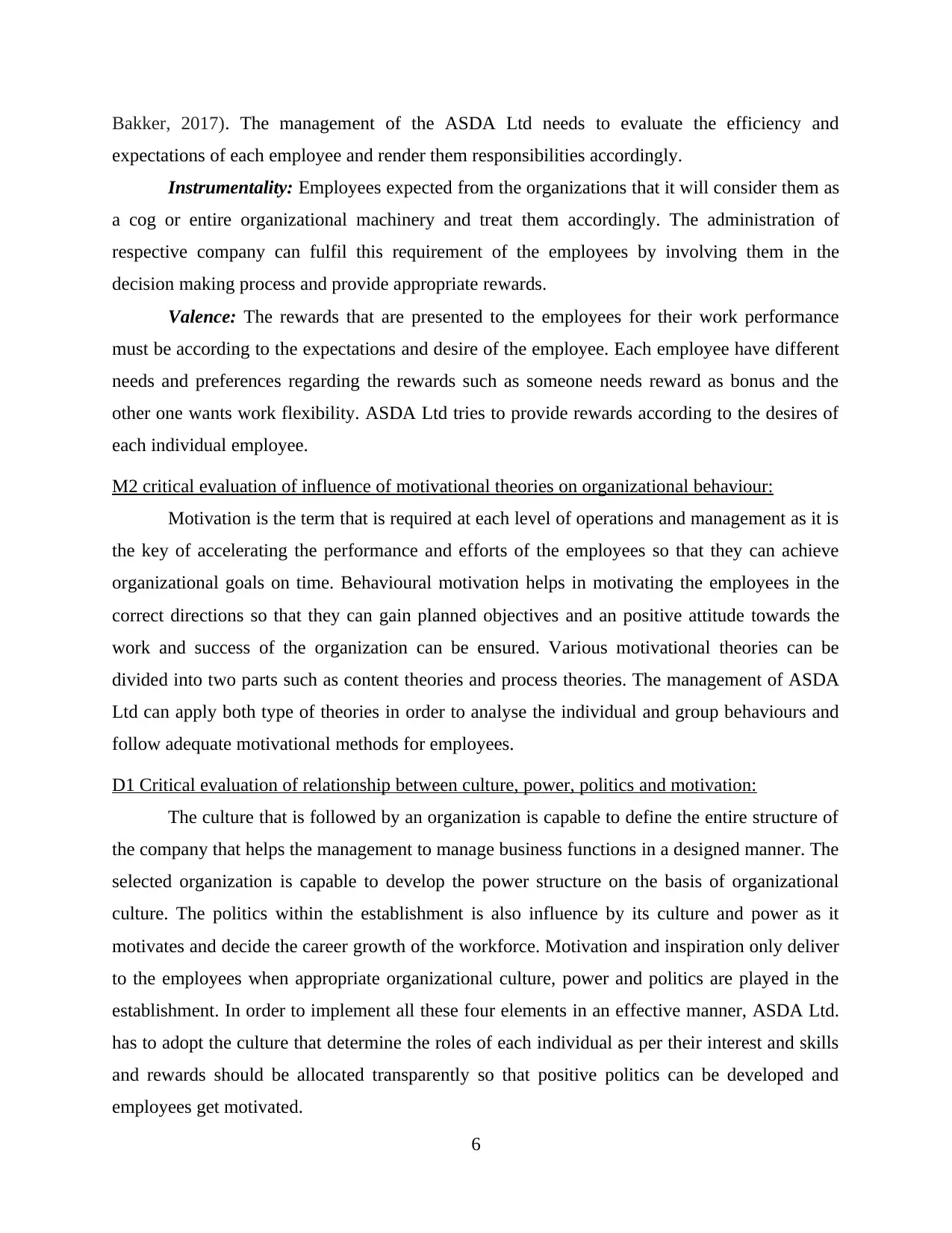
Bakker, 2017). The management of the ASDA Ltd needs to evaluate the efficiency and
expectations of each employee and render them responsibilities accordingly.
Instrumentality: Employees expected from the organizations that it will consider them as
a cog or entire organizational machinery and treat them accordingly. The administration of
respective company can fulfil this requirement of the employees by involving them in the
decision making process and provide appropriate rewards.
Valence: The rewards that are presented to the employees for their work performance
must be according to the expectations and desire of the employee. Each employee have different
needs and preferences regarding the rewards such as someone needs reward as bonus and the
other one wants work flexibility. ASDA Ltd tries to provide rewards according to the desires of
each individual employee.
M2 critical evaluation of influence of motivational theories on organizational behaviour:
Motivation is the term that is required at each level of operations and management as it is
the key of accelerating the performance and efforts of the employees so that they can achieve
organizational goals on time. Behavioural motivation helps in motivating the employees in the
correct directions so that they can gain planned objectives and an positive attitude towards the
work and success of the organization can be ensured. Various motivational theories can be
divided into two parts such as content theories and process theories. The management of ASDA
Ltd can apply both type of theories in order to analyse the individual and group behaviours and
follow adequate motivational methods for employees.
D1 Critical evaluation of relationship between culture, power, politics and motivation:
The culture that is followed by an organization is capable to define the entire structure of
the company that helps the management to manage business functions in a designed manner. The
selected organization is capable to develop the power structure on the basis of organizational
culture. The politics within the establishment is also influence by its culture and power as it
motivates and decide the career growth of the workforce. Motivation and inspiration only deliver
to the employees when appropriate organizational culture, power and politics are played in the
establishment. In order to implement all these four elements in an effective manner, ASDA Ltd.
has to adopt the culture that determine the roles of each individual as per their interest and skills
and rewards should be allocated transparently so that positive politics can be developed and
employees get motivated.
6
expectations of each employee and render them responsibilities accordingly.
Instrumentality: Employees expected from the organizations that it will consider them as
a cog or entire organizational machinery and treat them accordingly. The administration of
respective company can fulfil this requirement of the employees by involving them in the
decision making process and provide appropriate rewards.
Valence: The rewards that are presented to the employees for their work performance
must be according to the expectations and desire of the employee. Each employee have different
needs and preferences regarding the rewards such as someone needs reward as bonus and the
other one wants work flexibility. ASDA Ltd tries to provide rewards according to the desires of
each individual employee.
M2 critical evaluation of influence of motivational theories on organizational behaviour:
Motivation is the term that is required at each level of operations and management as it is
the key of accelerating the performance and efforts of the employees so that they can achieve
organizational goals on time. Behavioural motivation helps in motivating the employees in the
correct directions so that they can gain planned objectives and an positive attitude towards the
work and success of the organization can be ensured. Various motivational theories can be
divided into two parts such as content theories and process theories. The management of ASDA
Ltd can apply both type of theories in order to analyse the individual and group behaviours and
follow adequate motivational methods for employees.
D1 Critical evaluation of relationship between culture, power, politics and motivation:
The culture that is followed by an organization is capable to define the entire structure of
the company that helps the management to manage business functions in a designed manner. The
selected organization is capable to develop the power structure on the basis of organizational
culture. The politics within the establishment is also influence by its culture and power as it
motivates and decide the career growth of the workforce. Motivation and inspiration only deliver
to the employees when appropriate organizational culture, power and politics are played in the
establishment. In order to implement all these four elements in an effective manner, ASDA Ltd.
has to adopt the culture that determine the roles of each individual as per their interest and skills
and rewards should be allocated transparently so that positive politics can be developed and
employees get motivated.
6
⊘ This is a preview!⊘
Do you want full access?
Subscribe today to unlock all pages.

Trusted by 1+ million students worldwide
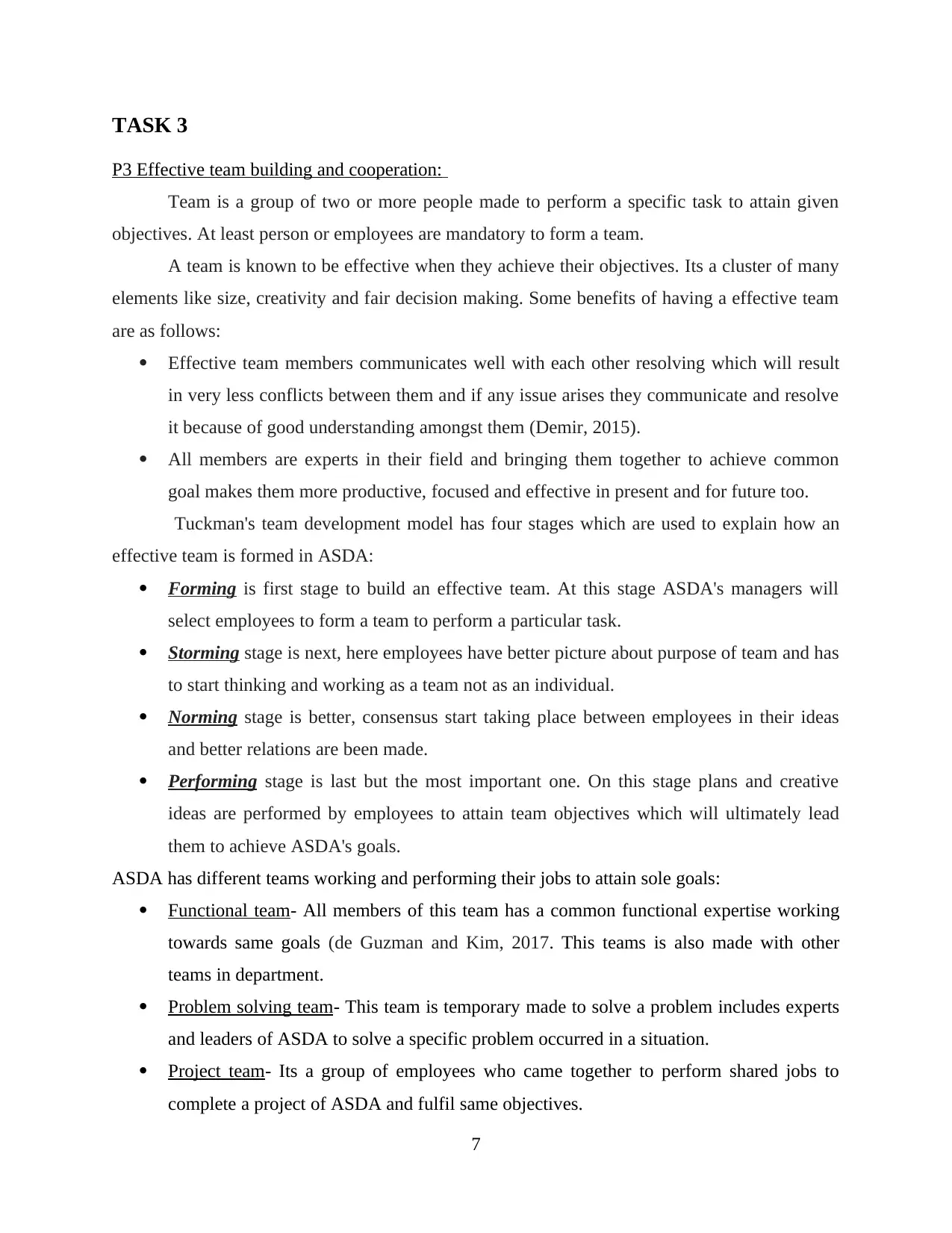
TASK 3
P3 Effective team building and cooperation:
Team is a group of two or more people made to perform a specific task to attain given
objectives. At least person or employees are mandatory to form a team.
A team is known to be effective when they achieve their objectives. Its a cluster of many
elements like size, creativity and fair decision making. Some benefits of having a effective team
are as follows:
Effective team members communicates well with each other resolving which will result
in very less conflicts between them and if any issue arises they communicate and resolve
it because of good understanding amongst them (Demir, 2015).
All members are experts in their field and bringing them together to achieve common
goal makes them more productive, focused and effective in present and for future too.
Tuckman's team development model has four stages which are used to explain how an
effective team is formed in ASDA:
Forming is first stage to build an effective team. At this stage ASDA's managers will
select employees to form a team to perform a particular task.
Storming stage is next, here employees have better picture about purpose of team and has
to start thinking and working as a team not as an individual.
Norming stage is better, consensus start taking place between employees in their ideas
and better relations are been made.
Performing stage is last but the most important one. On this stage plans and creative
ideas are performed by employees to attain team objectives which will ultimately lead
them to achieve ASDA's goals.
ASDA has different teams working and performing their jobs to attain sole goals:
Functional team- All members of this team has a common functional expertise working
towards same goals (de Guzman and Kim, 2017. This teams is also made with other
teams in department.
Problem solving team- This team is temporary made to solve a problem includes experts
and leaders of ASDA to solve a specific problem occurred in a situation.
Project team- Its a group of employees who came together to perform shared jobs to
complete a project of ASDA and fulfil same objectives.
7
P3 Effective team building and cooperation:
Team is a group of two or more people made to perform a specific task to attain given
objectives. At least person or employees are mandatory to form a team.
A team is known to be effective when they achieve their objectives. Its a cluster of many
elements like size, creativity and fair decision making. Some benefits of having a effective team
are as follows:
Effective team members communicates well with each other resolving which will result
in very less conflicts between them and if any issue arises they communicate and resolve
it because of good understanding amongst them (Demir, 2015).
All members are experts in their field and bringing them together to achieve common
goal makes them more productive, focused and effective in present and for future too.
Tuckman's team development model has four stages which are used to explain how an
effective team is formed in ASDA:
Forming is first stage to build an effective team. At this stage ASDA's managers will
select employees to form a team to perform a particular task.
Storming stage is next, here employees have better picture about purpose of team and has
to start thinking and working as a team not as an individual.
Norming stage is better, consensus start taking place between employees in their ideas
and better relations are been made.
Performing stage is last but the most important one. On this stage plans and creative
ideas are performed by employees to attain team objectives which will ultimately lead
them to achieve ASDA's goals.
ASDA has different teams working and performing their jobs to attain sole goals:
Functional team- All members of this team has a common functional expertise working
towards same goals (de Guzman and Kim, 2017. This teams is also made with other
teams in department.
Problem solving team- This team is temporary made to solve a problem includes experts
and leaders of ASDA to solve a specific problem occurred in a situation.
Project team- Its a group of employees who came together to perform shared jobs to
complete a project of ASDA and fulfil same objectives.
7
Paraphrase This Document
Need a fresh take? Get an instant paraphrase of this document with our AI Paraphraser
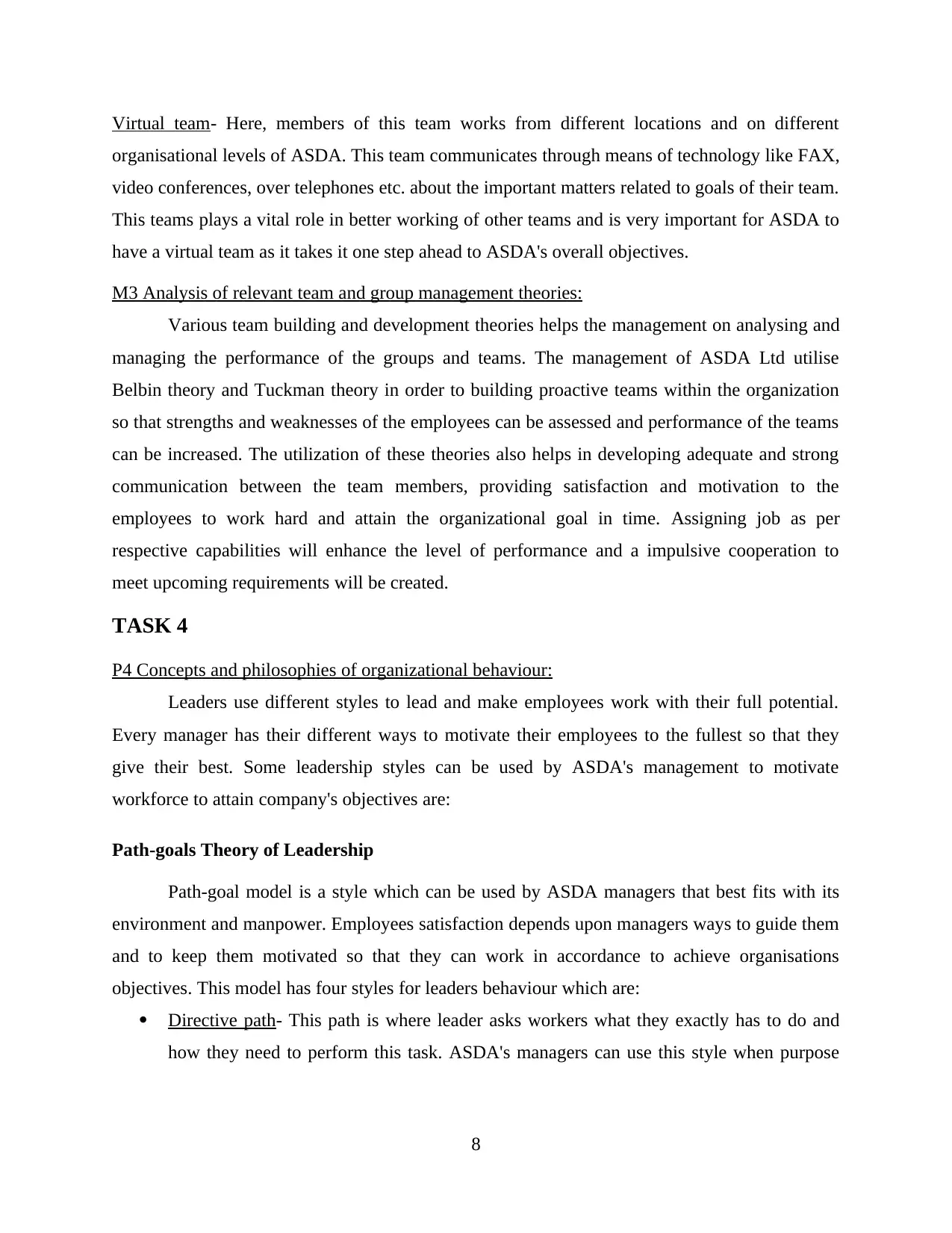
Virtual team- Here, members of this team works from different locations and on different
organisational levels of ASDA. This team communicates through means of technology like FAX,
video conferences, over telephones etc. about the important matters related to goals of their team.
This teams plays a vital role in better working of other teams and is very important for ASDA to
have a virtual team as it takes it one step ahead to ASDA's overall objectives.
M3 Analysis of relevant team and group management theories:
Various team building and development theories helps the management on analysing and
managing the performance of the groups and teams. The management of ASDA Ltd utilise
Belbin theory and Tuckman theory in order to building proactive teams within the organization
so that strengths and weaknesses of the employees can be assessed and performance of the teams
can be increased. The utilization of these theories also helps in developing adequate and strong
communication between the team members, providing satisfaction and motivation to the
employees to work hard and attain the organizational goal in time. Assigning job as per
respective capabilities will enhance the level of performance and a impulsive cooperation to
meet upcoming requirements will be created.
TASK 4
P4 Concepts and philosophies of organizational behaviour:
Leaders use different styles to lead and make employees work with their full potential.
Every manager has their different ways to motivate their employees to the fullest so that they
give their best. Some leadership styles can be used by ASDA's management to motivate
workforce to attain company's objectives are:
Path-goals Theory of Leadership
Path-goal model is a style which can be used by ASDA managers that best fits with its
environment and manpower. Employees satisfaction depends upon managers ways to guide them
and to keep them motivated so that they can work in accordance to achieve organisations
objectives. This model has four styles for leaders behaviour which are:
Directive path- This path is where leader asks workers what they exactly has to do and
how they need to perform this task. ASDA's managers can use this style when purpose
8
organisational levels of ASDA. This team communicates through means of technology like FAX,
video conferences, over telephones etc. about the important matters related to goals of their team.
This teams plays a vital role in better working of other teams and is very important for ASDA to
have a virtual team as it takes it one step ahead to ASDA's overall objectives.
M3 Analysis of relevant team and group management theories:
Various team building and development theories helps the management on analysing and
managing the performance of the groups and teams. The management of ASDA Ltd utilise
Belbin theory and Tuckman theory in order to building proactive teams within the organization
so that strengths and weaknesses of the employees can be assessed and performance of the teams
can be increased. The utilization of these theories also helps in developing adequate and strong
communication between the team members, providing satisfaction and motivation to the
employees to work hard and attain the organizational goal in time. Assigning job as per
respective capabilities will enhance the level of performance and a impulsive cooperation to
meet upcoming requirements will be created.
TASK 4
P4 Concepts and philosophies of organizational behaviour:
Leaders use different styles to lead and make employees work with their full potential.
Every manager has their different ways to motivate their employees to the fullest so that they
give their best. Some leadership styles can be used by ASDA's management to motivate
workforce to attain company's objectives are:
Path-goals Theory of Leadership
Path-goal model is a style which can be used by ASDA managers that best fits with its
environment and manpower. Employees satisfaction depends upon managers ways to guide them
and to keep them motivated so that they can work in accordance to achieve organisations
objectives. This model has four styles for leaders behaviour which are:
Directive path- This path is where leader asks workers what they exactly has to do and
how they need to perform this task. ASDA's managers can use this style when purpose
8
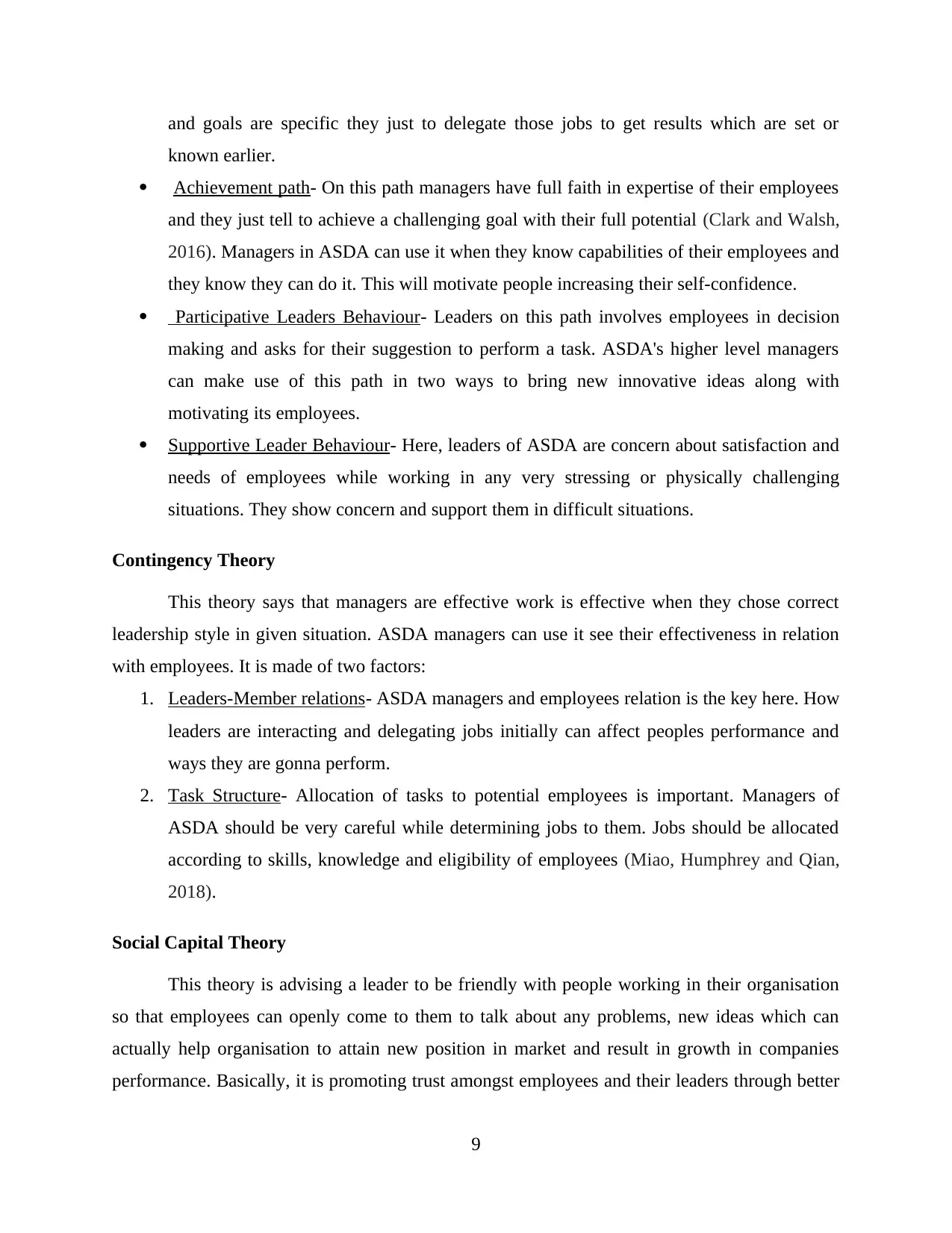
and goals are specific they just to delegate those jobs to get results which are set or
known earlier.
Achievement path- On this path managers have full faith in expertise of their employees
and they just tell to achieve a challenging goal with their full potential (Clark and Walsh,
2016). Managers in ASDA can use it when they know capabilities of their employees and
they know they can do it. This will motivate people increasing their self-confidence.
Participative Leaders Behaviour- Leaders on this path involves employees in decision
making and asks for their suggestion to perform a task. ASDA's higher level managers
can make use of this path in two ways to bring new innovative ideas along with
motivating its employees.
Supportive Leader Behaviour- Here, leaders of ASDA are concern about satisfaction and
needs of employees while working in any very stressing or physically challenging
situations. They show concern and support them in difficult situations.
Contingency Theory
This theory says that managers are effective work is effective when they chose correct
leadership style in given situation. ASDA managers can use it see their effectiveness in relation
with employees. It is made of two factors:
1. Leaders-Member relations- ASDA managers and employees relation is the key here. How
leaders are interacting and delegating jobs initially can affect peoples performance and
ways they are gonna perform.
2. Task Structure- Allocation of tasks to potential employees is important. Managers of
ASDA should be very careful while determining jobs to them. Jobs should be allocated
according to skills, knowledge and eligibility of employees (Miao, Humphrey and Qian,
2018).
Social Capital Theory
This theory is advising a leader to be friendly with people working in their organisation
so that employees can openly come to them to talk about any problems, new ideas which can
actually help organisation to attain new position in market and result in growth in companies
performance. Basically, it is promoting trust amongst employees and their leaders through better
9
known earlier.
Achievement path- On this path managers have full faith in expertise of their employees
and they just tell to achieve a challenging goal with their full potential (Clark and Walsh,
2016). Managers in ASDA can use it when they know capabilities of their employees and
they know they can do it. This will motivate people increasing their self-confidence.
Participative Leaders Behaviour- Leaders on this path involves employees in decision
making and asks for their suggestion to perform a task. ASDA's higher level managers
can make use of this path in two ways to bring new innovative ideas along with
motivating its employees.
Supportive Leader Behaviour- Here, leaders of ASDA are concern about satisfaction and
needs of employees while working in any very stressing or physically challenging
situations. They show concern and support them in difficult situations.
Contingency Theory
This theory says that managers are effective work is effective when they chose correct
leadership style in given situation. ASDA managers can use it see their effectiveness in relation
with employees. It is made of two factors:
1. Leaders-Member relations- ASDA managers and employees relation is the key here. How
leaders are interacting and delegating jobs initially can affect peoples performance and
ways they are gonna perform.
2. Task Structure- Allocation of tasks to potential employees is important. Managers of
ASDA should be very careful while determining jobs to them. Jobs should be allocated
according to skills, knowledge and eligibility of employees (Miao, Humphrey and Qian,
2018).
Social Capital Theory
This theory is advising a leader to be friendly with people working in their organisation
so that employees can openly come to them to talk about any problems, new ideas which can
actually help organisation to attain new position in market and result in growth in companies
performance. Basically, it is promoting trust amongst employees and their leaders through better
9
⊘ This is a preview!⊘
Do you want full access?
Subscribe today to unlock all pages.

Trusted by 1+ million students worldwide
1 out of 15
Related Documents
Your All-in-One AI-Powered Toolkit for Academic Success.
+13062052269
info@desklib.com
Available 24*7 on WhatsApp / Email
![[object Object]](/_next/static/media/star-bottom.7253800d.svg)
Unlock your academic potential
Copyright © 2020–2025 A2Z Services. All Rights Reserved. Developed and managed by ZUCOL.



